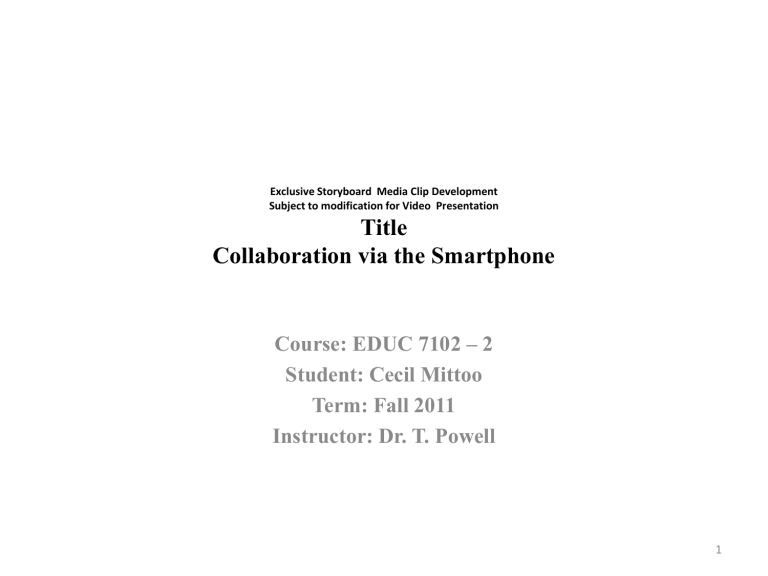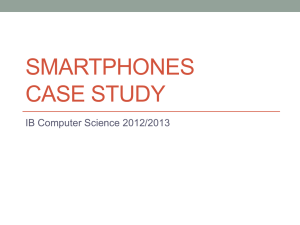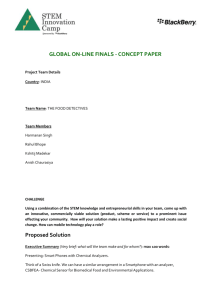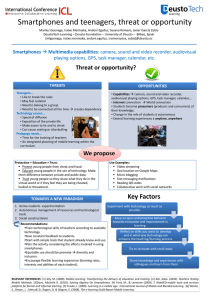Media Clip Development for Storyboard

Exclusive Storyboard Media Clip Development
Subject to modification for Video Presentation
Title
Collaboration via the Smartphone
Course: EDUC 7102 – 2
Student: Cecil Mittoo
Term: Fall 2011
Instructor: Dr. T. Powell
1
Introduction - Collaboration
• Collaboration is a phenomena to as be associated with K-12 communication, greater than just the passing information “back and forth.” Communicators are related in an activity that is meaningful and is expected to yield results, or arrive at a conclusion that satisfy the efforts, exchange of ideas and the applied technology. Collaboration is interactive to express positive results.
The Teaching and Learning with Technology Center espouses “By collaborating, students can develop their potential for learning.” Dr.
Thornburg [video presentation,2008] sees Cellphones as having great potential as a learning tool. Cellphones (Smartphone) carry new technology such as camera, data base, and calendar. Dr.
Thornburg espouses “Educators, people who design instructional programs whether in a corporate setting or educational institution
(K-12) for example, need to start thinking how these tools could be used in education so that when they become common place they’d be ready for it.”
2
Table of Contents
• Slide 1. Title
• Slide 2. Introduction – Collaboration
• Slide 3. Table of Contents
• Slide 4. Learning Technologies – Computers
• Slide 5. Smartphones as Computers
• Slide 6. Learning for 21 st Century
• Slide 7. Why Smartphones for Collaboration?
• Slide 8. Issues and Concerns of Smartphones for Collaborating
• Slide 9. Managing Smartphones in the Classroom
• Slide 10. Opportunities for Collaborating with Smartphone
• Slide 11. References
• Slide 12. Conclusion (to be written)
3
Learning Technologies-Computers
• Teaching, learning and assessing are parts and parcel of learning technology. According to
LTDI (1999) “Learning
Technology includes computer-based learning and multimedia materials and the use of networks and communications systems to support learning.”
• Technology Tools are:
• Computer Aided
Instruction
• Computer Aided Learning
• Computer Based Learning
• Computer Based Training
• Computer Aided
Assessment
• Computer Mediated
Communications
4
Smartphones as Computers
• Smartphones are small technology that are carrying the technology of the internet and the
World Wide Web. The internet and its browser services enables a social network that allows interacting for socializing, business, education.
• Smartphones broadband mobile technology have included 3G, 4G and now the 5G capabilities that makes information and communication transmission available at almost all locations in the city, rural areas and even in subways when allowed.
5
Learning for 21
st
Century
• 21 st century learning has taken on the evolution of the social environment. One significant evolutionary process that determines the quality of life is the process by which people communicate. Communication Technology enables time and space to defeat geographical boundaries. The trend in education is distance learning. The methods of learning is designed with parallels of the traditional education face to face encounters. The smartphone with its apps of live picture and video recording along with clear audio quality has successfully impacted the social system.
According to Dr. Siemens (video Presentation 2008a)people have established a comfort zone using technology for communicating. This feeling of social comfort is a cornerstone for collaborating with Smartphone technology.
6
Why Smartphones for Collaboration?
• Technology that dictates a social culture will spread into the education system, be it traditional or distance education.
Parents are arming their kids with technology that is personal and mobile. This means that inside the classroom students have at their disposal a technology that has immense values for “good or bad.” The good effects are what educators must draw on. Students must learn to transform social network of “gossip” into constructivism for co-knowledge building. Constructivism and Connectivism are learning theories that have at their common core
“interactive technology." Mohamed Ally in Anderson
(2010) tells that Siemens (2004) thinks “Connectivist theory is for the digital age, where individuals learn and work in a networked environment” (p. 34).
7
Issues and Concerns of Smartphones for Collaborating
• Concerned parents, teachers and administrators are voicing opinion and beliefs regarding the negative impact of
Smartphone technology in the classroom. The classroom is a closed learning environment that distractions spread to affect all. Smartphones are small and personal technology that can be used for unproductive and uneducated purposes in a discreet fashion. The teacher might not be aware at that moment. Consequently, an infamous activity could spiral into threat of student safety, security and vulnerability. The administrators understand that 21 st century technology will drive the curriculum for improved learning, but are also concerned with unwanted events that could spoil the image of their school and indices them into serious management incapability issues.
8
Managing Smartphones in the
Classroom
• All technology are susceptible to danger for its users and others if not managed properly and effectively. The Smartphone is no exception. All concerned personnel must come together and develop a system of control. This will involve parents who will exercise influence on safe use of the technology they give their child.
• The school board and administrators will develop technology safety use policy and disciplinary measures if violated.
• The teachers will be trained in identifying misuse and abuse of technology for inciting danger to self and others. Teachers will be trained when and how Smartphone will be used as a learning technology to integrate with instructional design. Caitlin Fertal (2001) point out that “Problems such as texting during class are avoided by less lenient policies, keeping the classroom focused on learning.”
• Students will be educated and trained to identify threats on their
Smartphone and steps to take for their safety and security. They will also have shared responsibility for proper application for collaboration and effective learning.
9
Opportunities for Collaborating with
Smartphone
• 21 st century technology is changing not just what people learn but also how they learn. The traditional learning environment has laid a foundation for cooperative learning that has proven to be effective within the classroom. The classroom walls are being extended to homes, offices, outdoors and even while travelling. Distance education is a fine example.
• The business and corporate world pioneers the path in which we should direct learners to extend learning via technology. Collaborative interaction needs a virtual forum for initializing. The Smartphone as students’ personal tools have the advantage for integrating learning in its social network. Social network integrates technology, communication and users.
• Neomillenal learning style speculates where learning is going in the future.
Dr. Dede [vodcast, 2008] sees a strong match in the kinds of media that students are using outside of formal learning. Dr. Dede says “It looks as if media based learning style is going in a direction that parallels what society is going to need in education , but we can only take advantage of that if we let students use in school the kind of powerful tools they use outside of the classroom setting.” Smartphones are powerful media tool.
10
References
•
•
•
•
•
•
•
•
•
LEARNING TECHNOLOGY DISSEMINATION INITIATIVE. LEARNING TECHNOLOGY DISSEMINATION INITIATIVE. Retrieved from: http://www.icbl.hw.ac.uk/ltdi/implementing-it/what-def.htm
Teaching and Learning With Technology Center (TLTC). (2003). Enabling student collaboration for learning. Retrieved from: http://www2.gsu.edu/~wwwltc/howto/enablestudentcollab.htm
Laureate Education, Inc. (Producer). (2008a). The Future of Distant Education [Dr. George Siemens’ Video Presentation]. Available from: http://laureate.ecollege.com/ec/crs/default.learn?CourseID=5260641&CPURL=laureate.ecollege.com&Survey=1&47=4769372&ClientN odeID=984645&coursenav=0&bhcp=1
Anderson, T. (Ed.). (2008). The Theory and Practice of Online learning. (2nd ed.). Edmonton, AB: Athabasca University Press. Chapter 1,
“ Foundations of Educational Theory for Online Learning” Mohamed Alley.
Fertal, C. (2011).The News-Herald. Schools integrate cellphones into class; some strict on unsupervised use. September 19, 2011.
Retrieved from: http://www.news-herald.com/articles/2011/09/19/news/nh4450063.txt
Laureate Education, Inc. (Producer). (2008). Educational Technology: The Miniaturization of Technology [Vodcast]. Available from http://laureate.ecollege.com/ec/crs/default.learn?CourseID=5260641&CPURL=laureate.ecollege.com&Survey=1&47=4769372&ClientN odeID=984645&coursenav=0&bhcp=1
.
Laureate Education, Inc. (Executive Producer). (2008).Millennial and Neomillennial Learning Styles. Baltimore: Author. [Vodcast].
Retrieved from: http://sylvan.live.ecollege.com/ec/crs/default.learn?CourseID=5260641&Survey=1&47=6051890&ClientNodeID=984645&coursenav=1
&bhcp=1
11
Conclusion
• Subject to construction at this time!
12






